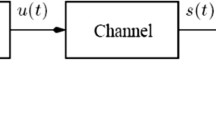Abstract
The orthogonal frequency-division multiplexing (OFDM) systems are highly sensitive to the nonlinear distortions introduced by the high-power amplifier at the transmitter and to the in-phase and quadrature (IQ) imbalance of the down converter at the receiver. In this paper, the joint effects of these impairments on the performance of the OFDM systems with M signal points quadrature amplitude modulation (M-QAM) are investigated. Moreover, the analytical formulations for the error vector magnitude, the bit error rate, and the total degradation performances of the M-QAM-OFDM systems in additive white Gaussian noise channels as a function of the output back off and IQ imbalance parameters are derived. The computer simulation results confirm the accuracy and validity of our proposed analytical approach.













Similar content being viewed by others
References
Van Nee R, Prasad R (2000) OFDM for wireless multimedia communications. Artech House, London
Kennington PB (2000) High-linearity RF amplifier design. Artech House, London
Razavi B (1998) RF microelectronics. Prentice-Hall, Englewood Cliffs
Tarighat A, Bagheri R, Sayed AH (2005) Compensation schemes and performance analysis of IQ inhabitants in OFDM receivers. IEEE Trans Signal Process 53(8):3257–3268
Tubbax J, Come B, Van der Perre L, Donnay S, Engels M (2003) IQ imbalance compensation for OFDM systems. IEEE Int Conf Commun 5:3403–3407
Liu CL (1998) Impacts of I/Q imbalance on QPSK-OFDM-QAM detection. IEEE Trans Consumer Electron 44(3):984–989 Aug
Rykaczewski P, Valkama M, Renfors M (2006) Analytical approach to IQ imbalance in OFDM, CDMA and MC-CDMA based systems. In: Proc IEEE Radio and Wireless Symposium, pp 555–558, Jan
Zareian H, Vakili VT (2007) Analytical BER performance of M-QAM-OFDM systems in the presence of IQ imbalance. In: Fourth International Conference on Wireless and Optical Communications Networks (WOCN2007), pp 1–5, Jul
Santella G, Mazzenga F (1998) A hybrid analytical-simulation procedure for performance evaluation in M-QAM-OFDM schemes in presence of nonlinear distortions. IEEE Trans Veh Tech 47:142–151 Feb
Costa E, Midrio M, Pupolin S (1999) Impact of amplifier nonlinearities on OFDM transmission system performance. IEEE Comm Lett 3(2):37–39 Feb
Dardari D, Tralli V, Vaccari A (2000) A theoretical characterization of nonlinear distortion effects in OFDM systems. IEEE Trans Commun 48:1755–1764
Banelli P, Cacopardi S (2000) Theoretical analysis and performance of OFDM signals in nonlinear AWGN channels. IEEE Trans Commun 48:430–441
Banelli P, Baruffa G, Cacopardi S (2001) Effects of HPA nonlinearity on frequency multiplexed OFDM signals. IEEE Trans Broadcast 47(2):123–136
Zareian H, Vakili VT (2008) Analysis of nonlinear distortion using orthogonal polynomials HPA model. Int J Comp Sci Netw Secur 8(1):164–169
Costa E, Pupolin S (2002) M-QAM-OFDM system performance in the presence of nonlinear amplifier and phase noise. IEEE Trans Commun 50(3):462–472 Mar
Zheng ZW, Yang ZX, Pan CY, Zhu YS (2005) Effects of nonlinear distortion and imperfect parameters estimation on the performance of OFDM-based DTTB systems. IEEE Trans Broadcasting 51:237–243 June
Zheng ZW, Yang ZX, Pan CY, Zhu YS (2004) Performance analysis of the OFDM-based systems with nonlinear distortion and imperfect parameters estimation. IEEE Trans Consum Electron 50:835–843
Saleh AA (1981) Frequency independent and frequency dependent nonlinear models of TWT amplifiers. IEEE Trans Commun 29:1715–1720
Minkoff J (1985) The role of AM-to-PM conversion in memoryless nonlinear systems. IEEE Trans Commun COM-33:139–143
Zhao C, Baxley RJ (2006) Error vector magnitude analysis for OFDM systems. In: Proc. IEEE 40th Asilomar Conference on Signals, Systems, and Computers, Pacific Grove, CA, pp 1830–1834, Oct
Georgiadis A (2004) Gain, phase imbalance, and phase noise effects on error vector magnitude. IEEE Trans Veh Tech 53(2):443–449
Proakis JG (2001) Digital communications. McGraw-Hill, New York
Digital Video Broadcasting (2001) ETSI EN 300 744 V1.4.1, Digital Video Broadcasting (DVB): Frame structure, channel coding and modulation for digital terrestrial television.
Author information
Authors and Affiliations
Corresponding author
Rights and permissions
About this article
Cite this article
Zareian, H., Vakili, V.T. Analytical EVM, BER, and TD performances of the OFDM systems in the presence of jointly nonlinear distortion and IQ imbalance. Ann. Telecommun. 64, 753 (2009). https://doi.org/10.1007/s12243-009-0116-z
Received:
Accepted:
Published:
DOI: https://doi.org/10.1007/s12243-009-0116-z




